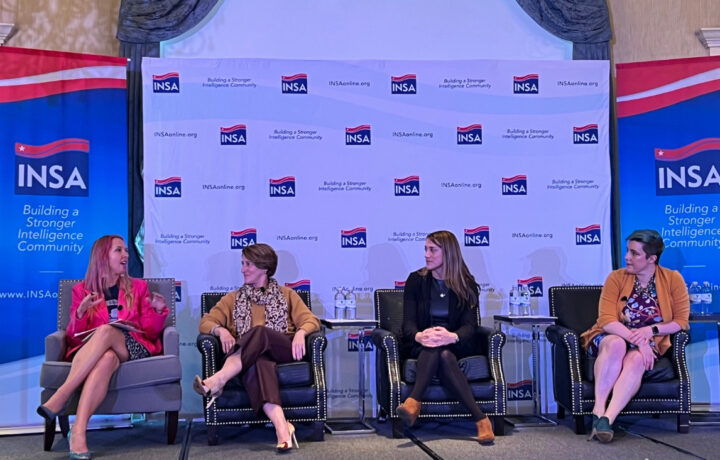Remote work and SCIF life have been hot topics in national security, following the pandemic. Leaders have rightly noted that what we made work during 2020 and its aftermath, we should apply going forward. While not every job can be done remotely, technology and policy continue to evolve to make possible what was never before. The afternoon panel at INSA’s The New IC event, moderated by our very own ClearanceJobs Director of Content and PR, Lindy Kyzer, took a deep dive into this topic. Kyzer noted that remote job openings on our site have grown from .5% before 2021 to currently 4%. And the trend shows signs of continuing in that upward trajectory.
Changes to Remote and Hybrid Work
Defense Counterintelligence and Security Agency (DCSA) Chief of Staff Ellen Ardrey shared that their agency offered different work options even before 2020. The nature of background investigators and field work lends itself to cleared positions with the much of the work being done remotely. They also have employees distributed among 168 locations. However, Ardrey shared that the pandemic did act as an accelerator for DCSA in bringing about changes in their approach to work.
Melissa Kepler, Deloitte Internal Facilitation Team, said, “It’s harder to manage a hybrid workforce. But it doesn’t mean that we shouldn’t do it.” There’s no reason to shift back to the default mode. And the reality is that with multiple office locations, managers are already dealing with a hybrid workforce. National Security Agency (NSA) Director of NSA Future-Ready Workforce Initiative, Kristina Walter, agreed, saying that NSA has had its own cultural shift to grow hybrid options. It’s important for everyone to work together to find the right solution – both managers and employees.
Changes to the Classified Work Day
A noticeable shift over the past three years has been the work day. Up until 2020, working in national security – either as an on-site contractor or employee – meant putting in an eight-hour non-severable day. Following the pandemic, Ardrey shared that there’s a shift towards adjusting times when people log in and out of the system, depending on their personal schedules and work requirements. If we embrace the shifts that have happen, Ardrey noted that we can create a culture that allows people more flexibility.
Remote work offerings has impacted DCSA’s recruiting efforts for key positions. Ardrey said that their contracting office openings struggled to rise above 62% fulfillment before the pandemic. Now that the position is offered as remote, recruiting efforts have hit 100%.
Ardrey pointed out that there’s a psychological component when bringing about change. Unless people think something is broken, they won’t want to make changes to fix anything. However, addressing flexibility for employees will help with recruiting, retention, and stagnation issues that the federal government has faces.
NSA Solves The Security Clearance Waiting Problem
Walter explained the challenges that NSA has had with recruiting and retaining their workforce. NSA has been on an aggressive hiring campaign in 2023, and changes that they’ve made over the past three years will help. She explained it’s been helpful to move past just focusing on the applicants who survived the lengthy suitability and security clearance process. NSA has begun to look at why people didn’t make it through the process. NSA has revamped their onboarding process, creating a vision for applicants on what the work will look like.
Kepler shared that it’s been a shift in how we view work. Instead of asking clearance holders to find ways to survive, Kepler said, “It’s about adjusting the whole parameter.” But we can also implement things that we already have. Kepler noted that we can stop simply admiring this problem, and instead, we can move out with policies that are already in place. Kyzer agreed, saying, “Changing the culture is finding the policy that says yes instead of looking for the ones that say no.”
NSA has not only used policy, but they’ve also created spaces and programs that help differentiate between what needs to happen on the high side versus low side. Walters said they’ve done this with flex spaces and hoteling options throughout the organization. But they’ve also taken strides in offering a space and work for applicants waiting for their security clearance to finalize. Government contractors are often able to achieve this, offering unclassified work to new employees waiting for their clearance, but IC agencies have often been forced to make applicants wait a long time until everything is finalized before onboarding.
Benefits of SCIF Life
A lot of misconceptions about the level of availability and connectivity in the SCIF life are floating around; however, there’s elements of truth in the rumors. Stepping into the SCIF does create a more compartmentalized approach to work and life. But that’s not why people in national security do it. It’s the mission of national security work that draws people to the job.
“You can do things in a SCIF that you can never do anywhere else,” quipped Walters. If you want to be a part of something, this is it. Time and technology will help make SCIFs more accessible, but that doesn’t change the importance of the work in national security.




